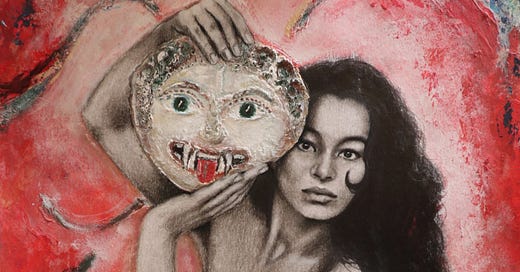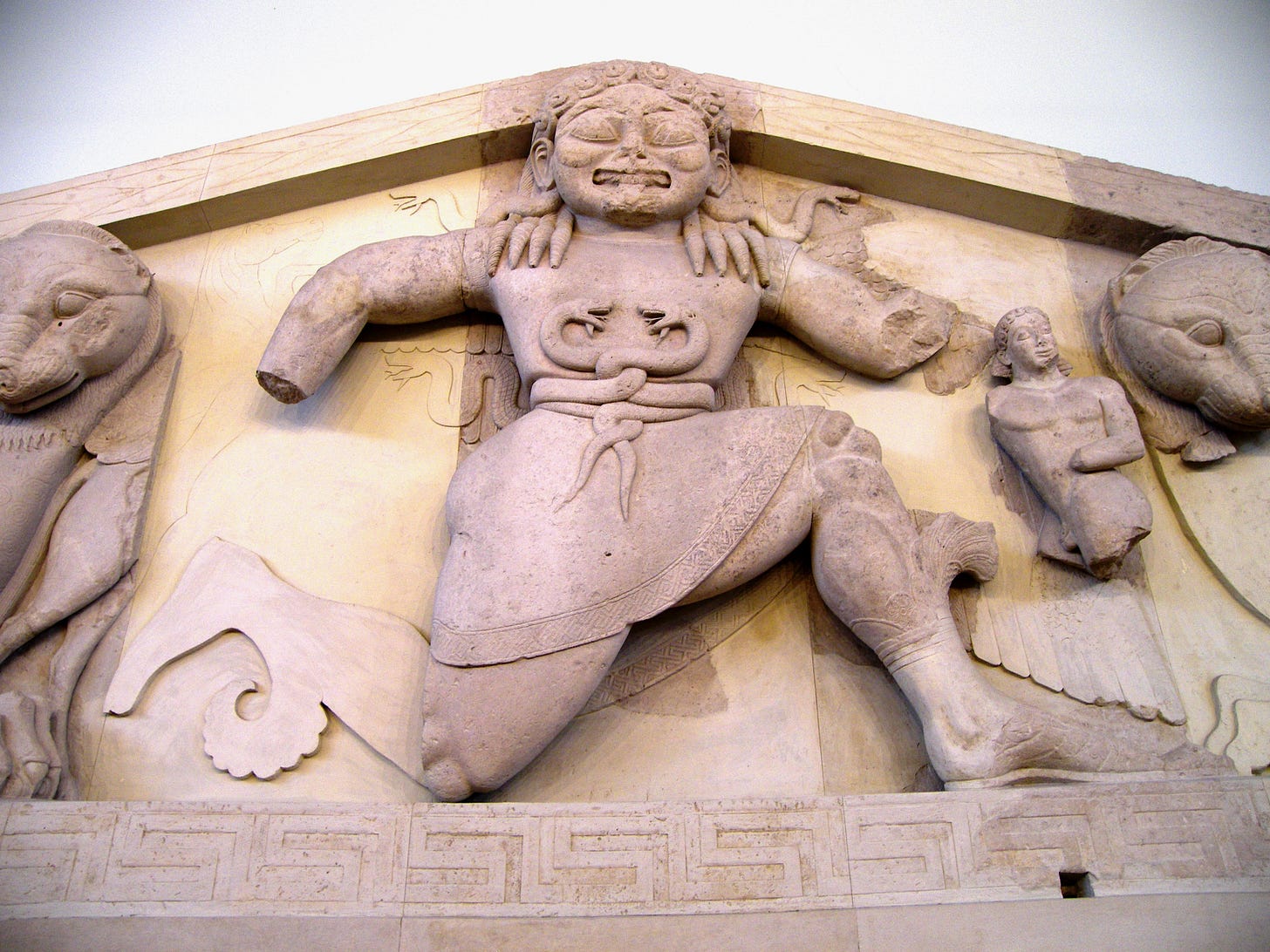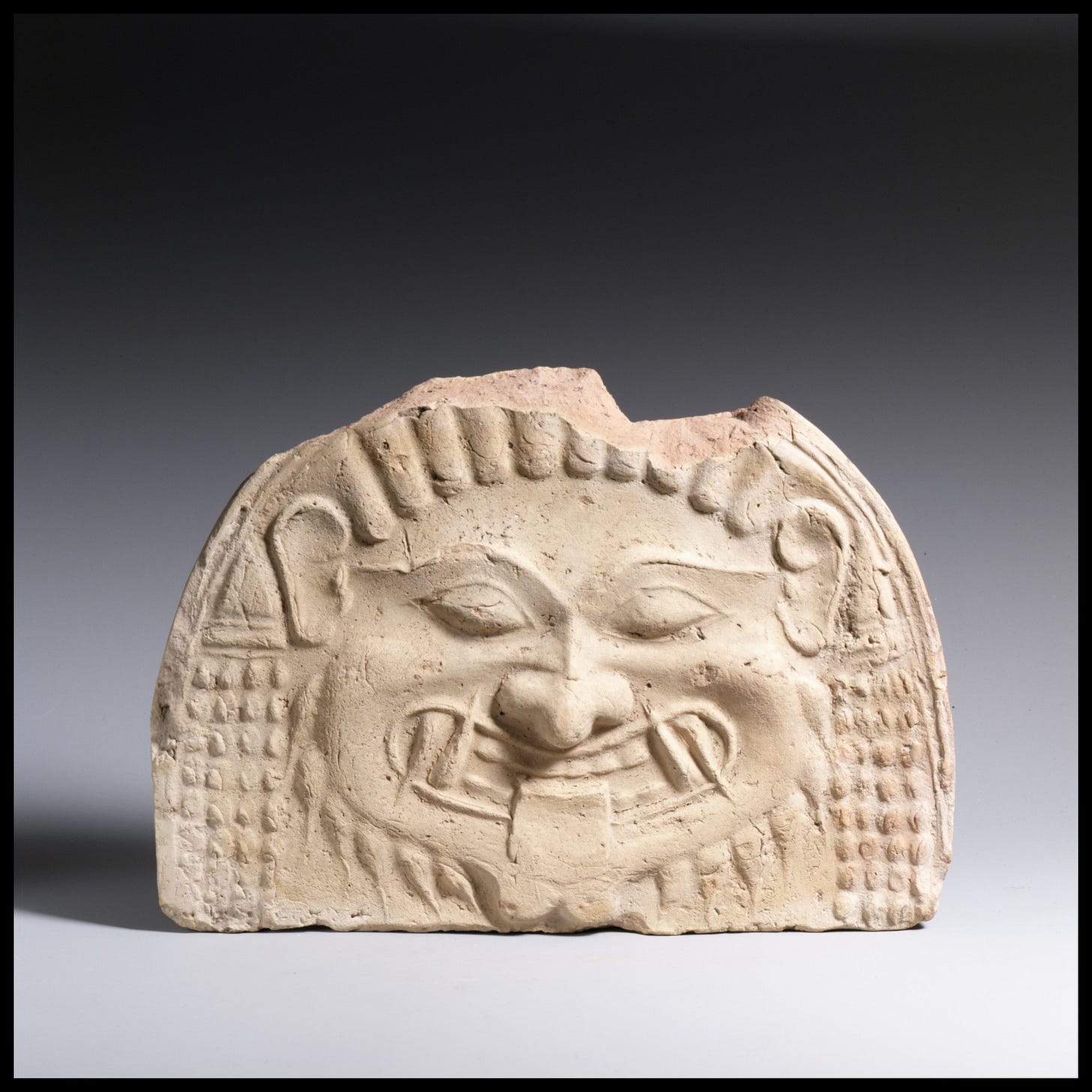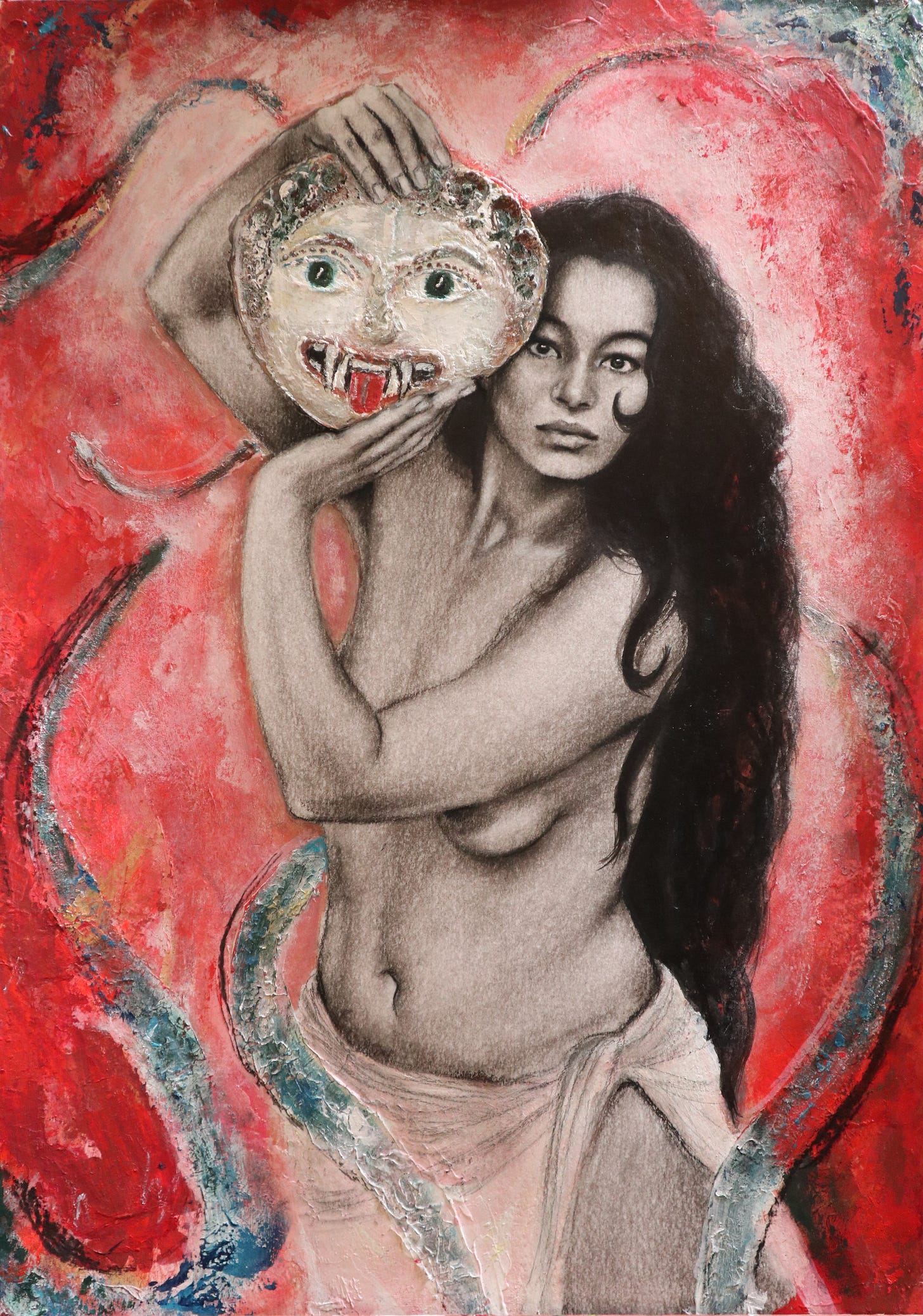It’s time to meet her gaze.
The story of Medusa has been passed down in fragments.
In whispers from ancient stone.
And scattered words from different men who feared her.
But stories carry layers...
And sometimes, the version we know is just a cover.
Hiding something wilder.
More mysterious.
And long forgotten.
The Medusa You Think You Know
If you’ve heard the story, it probably went like this:
A beautiful virgin priestess is raped by Poseidon (god of the sea and bad boundaries). And instead of punishing him, Athena curses Medusa, turning her into a monster.
Later, the hero Perseus beheads her, with Athena’s full support.
(I break the myth down in a way that hits you right in the gut. Read it here.)
But here’s the twist:
This version is not even original!
It’s not Greek.
It was crafted much later, by the Roman poet Ovid.
For him, myth was a mesmerizing sea he drifted through, fishing for drama, transformation, and anything shimmering with strong emotions.
And when the sea didn’t cough up enough pearls?
Well, he made his own.
Before Ovid, Medusa was never a woman.
Never beautiful.
His Metamorphosis, written around the year 8 AD, gave her a full glow-up.
And then some tragedy on top.
The rape?
That was pure Ovid spice.
So let’s go back in the past and see what’s been hiding under these embellishments.
What the Greeks Actually Said
I don’t know if this will land as a relief or a disappointment… but the original Medusa wasn’t a cursed beauty.
She was a beast from the start.
The core of the Greek myth comes from Hesiod’s Theogony, written around the 8th century BCE.
Hesiod didn’t reinvent old tales.
The world he lived in was still humming with oral tradition.
So he tried to organize it into a cosmic origin story, a divine family tree.
In that system, Medusa is just one of many monstrous beings, born of primordial sea gods Phorcys and Ceto. She has two sisters, Stheno and Euryale.
And Medusa alone is mortal, as he points out.
But there’s no mention of Athena.
No curse.
No rape.
Instead, Poseidon shows up as that dark-haired god who just… lies with Medusa in a soft meadow, surrounded by spring flowers.
(Like your favorite low-key romantic movie scene. And far away from Ovid’s violent temple intrusion. )
Later, Perseus beheads Medusa.
And from her blood, two magical creatures are born: Pegasus, the winged horse, and Chrysaor, the golden warrior.
Her children with Poseidon.
That’s it. No drama. No moral lesson. Just mythic origins, raw and cosmic.
Medusa wasn’t a victim of transformation.
She was an offspring of older gods who roamed the world before Zeus and the Olympians took power.
An echo of a more ancient world.
(One who, crucially, was still vulnerable enough to be slain by a champion of the new order of gods.)
Fast forward to around the 1st or 2nd century BCE: we get the Bibliotheca, a myth compilation attributed to someone we now call Pseudo-Apollodorus (he definitely didn’t name himself that).
His goal was to weave together different versions of myths into a single, coherent system.
And there’s where we get the full hero’s journey: Perseus sent to slay Medusa, aided by Athena and Hermes, equipped with divine gear.
Medusa is still the only mortal Gorgon.
But still not human.
And still, there’s no rape.
Poseidon isn’t even mentioned!
When Perseus cuts Medusa’s head off, out spring her children like surprise mythic offerings, with no backstory.
You can catch the pattern, can’t you…
The earlier the myth, the fewer the details.
But the more intact Medusa’s original nature remains.
Facing the Real Medusa
So let’s go deeper…
Into the past.
Into the myth.
And then, beyond the words themselves.
Let’s turn our gaze to Medusa.
The real Medusa.
Image by Dr. K., licensed under CC BY-SA 3.0, via Wikimedia Commons.
Just look at her.
This is not a victim-turned-monster, waiting to be killed.
This is a powerful, ancient force.
Feared and revered.
This stone relief of Medusa stands at the threshold of the oldest Greek temple ever found: the Temple of Artemis in Corfu, built around 580 BCE.
She meets your gaze at the doorway between worlds, the profane and the sacred.
Her presence isn’t decorative.
It’s protective.
She is a guardian.
A fierce, feminine force defending the temple of Artemis, goddess of the wilderness.
Medusa represents the power from below—the underworld, the womb, the root.
She rises from beneath the earth to protect what lives on the surface, through the raw power of her gaze.
She’s flanked by panthers.
Symbols of chthonic protection.
(Chthonic just means originating from the earth, from the underworld, from below)
She not only guards the boundary.
She is the boundary.
She is the line between light and dark.
Danger and safety.
Life and its return to the depths.
And the further back we go, the clearer it becomes:
Medusa is a feral cosmic force.
A presence so potent…
She didn’t even need a body.
Wait—what?
When the Head Alone Is Enough
This is where things get wilder.
The oldest written mention of Medusa comes from the great Homer (around 750 -700 BC).
He is the voice that shaped Greek myth as we know it.
And yet… there’s no story.
No sisters.
No Perseus.
No Athena.
No Poseidon.
Homer doesn’t even call her Medusa.
And she doesn’t even have a body.
There’s just… a head.
In the Odyssey, when Odysseus travels to the land of the dead, he warns he must flee quickly, before the dreadful Gorgon’s head rises from the underworld.
And in the Iliad, her head is carved into Athena’s shield, radiating terror, warding off enemies with its petrifying gaze.
In Homer’s world, “Gorgo” is not mortal.
Not even a character.
She is a symbol of a liminal force.
A terror that guards the edge of the world.
Untouched by narrative.
And untamed.
But this sacred, terrifying head didn’t appear out of nowhere.
Before the story, there was a symbol.
Before the myth, there was the head.
Long before Homer, her image was everywhere in ancient Greece.
The monstrous female face.
Wide eyes. Open mouth. Tongue out. Sometimes tusked. Sometimes crowned with snakes.
She glared from the high points of temples, daring any malevolence to cross the line.
She hung at graves, at homes, at gates.
Carved in shields.
Painted on pottery.
Terracotta Gorgoneion Antefix (ca. 580–570 BCE)
These images —called Gorgoneion—were not meant to be beautiful.
They were meant to stop you cold.
Not in fear.
But in recognition that something ancient is watching you back.
The Gorgoneion was an apotropaic image, meaning it was designed to ward off harm.
It wasn’t decoration.
It was a warning.
A spell.
The Gorgon was never monstrous because she was a monster—
but because she protected from monsters.
The oldest known depictions of this face date back to around 900 BCE.
That’s two centuries before Homer.
(And nine centuries before Ovid’s “Beauty and Punishment.”)
The Face That Came Before
But we can go even further...
This kind of fierce, liminal face, mouth agape, eyes wide open, is older than the alphabet.
We see versions of it across the ancient Mediterranean and Near East.
It shows up in Mesopotamian demon masks, used to frighten sickness and spirits.
In Egyptian amulets, carved with protective deities whose gazes pierced both the seen and unseen.
In Anatolian and Minoan iconography, where goddesses wield snakes and stare directly outward.
Unblinking.
Undisturbed.
It echoes even in Neolithic Europe, where we find clay faces at doorways— watchers at the threshold.
They didn’t depict specific gods.
They were the presence of protection itself.
A mask you couldn't pass without meeting yourself.
And isn’t that what the Gorgoneion does?
It doesn’t attack. It doesn’t chase.
It confronts.
It dares you to cross.
To meet what you fear most.
So while the Greeks would later tell stories of how Medusa was slain and tamed, her face continued to guard their sacred spaces.
Even Athena, the goddess who bore her death, wore the Gorgoneion on her shield.
Because something in them still remembered the face that held power.
Not because it was monstrous.
But because it was sovereign.
The wild feminine protector.
Not gentle. Not pretty. Not palatable.
But necessary.
And when you stand before it, you don’t look away.
You look in.
Ovid, We Need to Talk
So isn’t all of this enough?
Can we now please peel off Ovid’s golden paint?
Scrub away the drama?
Can we collectively carve into our myth-loving minds that the Medusa-as-victim didn’t exist in the original bones of the myth?
In the Roman world, a presence like Medusa’s had to have a context and history.
So instead of being the cosmic force she always was, or even just a beast from the Greek myths, she had to fall.
From extreme beauty to extreme monstrosity.
And it is a compelling arc, you must admit.
Of course, Ovid needed a proper metamorphosis, or else she wouldn't make the cut.
So he aestheticized her.
And victimized her.
Not, perhaps, to consciously hurt what she truly represented.
But to fit her into a literary mold, where explanations, tragedy, and drama were highly appreciated.
Where violation was a literary mechanism to stir pathos.
He did his best to make her digestible for his time.
Manageable.
Ovid’s story of Medusa mirrors cultural anxieties around female sexuality, shame, and punishment.
Ideas that belonged to that time.
But still ripple through the undercurrents of our collective subconscious.
And here lies the paradox.
Medusa’s fall didn’t begin when she became a monster, but when she was rewritten as a victim.
She lost her mystery.
She lost her sovereignty.
She lost her wild power.
She was tamed.
And yet… even in that distorted form,
She kept staring back.
Her image kept appearing.
In sculpture. In art. In temples. In dreams.
Because, even almost diminished, a symbol that ancient, that potent can’t be erased.
It can’t be killed.
She was just buried under layers of history, patriarchy, and fear.
But today, we can hold her.
We can handle her.
We are ready for her.
So it’s time we stop polishing Ovid’s chains.
And remember Medusa for what she always was.
A wild feminine force.
Never slayable.
Never mortal.
Never a victim.
Always brimming with the mystery of life and death.
Always alive.
Alive in you.
Can you feel her?







oh my god i loved the analysis! this all so true and so infuriating. ovid did all that to fuel his poltical and anti-authoritarian views, and not just this story, arachne? from what i can remember, also Ovid.
I’ve never heard of any of this… I feel like you breaking down the myth in the first part (and drawing attention to the women in it) developed my perception of the myth as I knew it, but this really changed it. The power she had being buried like that… there’s so many layers. I think it’s interesting how the story evolved so much and then stayed (seemingly) consistent afterward. Thank you for writing and sharing this!